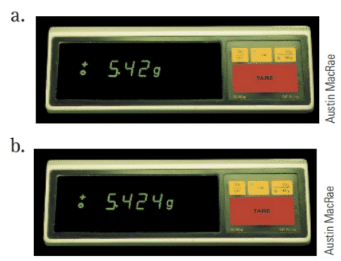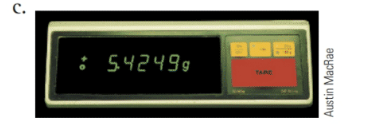
Chemistry In Focus
7th Edition
ISBN: 9781337670425
Author: Tro
Publisher: Cengage
expand_more
expand_more
format_list_bulleted
Concept explainers
Textbook Question
Chapter 2, Problem 52E
Consider each of the following balances. Which one is the most precise? Which one is the least? How much uncertainty is associated with each balance?


Expert Solution & Answer
Trending nowThis is a popular solution!

Students have asked these similar questions
Hi can you please help me solve these problems? thank you
Hi can you please help me solve these problems? thank you
Hi can you please help me solve this problem? thank you
Chapter 2 Solutions
Chemistry In Focus
Ch. 2 - The volume of a liquid can be measured with a...Ch. 2 - Scientific Notation Express the number 0.0000023...Ch. 2 - Prob. 2SCCh. 2 - Prob. 3SCCh. 2 - Converting Between Units Convert 34.0 cm to...Ch. 2 - Prob. 2.3YTCh. 2 - Extracting Information from Graphical Data The...Ch. 2 - Solving Word Problems...Ch. 2 - Solving Word Problems Involving Units Raised to a...Ch. 2 - Prob. 2.7YT
Ch. 2 - Prob. 2.8YTCh. 2 - Without doing any calculations, determine whether...Ch. 2 - Prob. 1ECh. 2 - Prob. 2ECh. 2 - Prob. 3ECh. 2 - What is the difference between reporting the...Ch. 2 - Prob. 5ECh. 2 - Prob. 6ECh. 2 - Prob. 7ECh. 2 - Prob. 8ECh. 2 - Prob. 9ECh. 2 - What is a conversion factor? Give two examples of...Ch. 2 - Prob. 11ECh. 2 - Identify the decimal part, the exponential part,...Ch. 2 - What is density? Give two examples of possible...Ch. 2 - Since oil floats on water, what can you say about...Ch. 2 - Express each of the following in scientific...Ch. 2 - Express each of the following numbers in...Ch. 2 - Express each of the following in decimal notation:...Ch. 2 - Express each of the following in decimal notation:...Ch. 2 - The circumference of Earth at the equator is...Ch. 2 - The distance from New York to Los Angeles is 2777...Ch. 2 - A can of soda contains 12 fluid ounces. What is...Ch. 2 - A laboratory beaker can hold 150mL. How many fluid...Ch. 2 - A car has a fuel efficiency of 27 miles per...Ch. 2 - A European rental car can travel 17 km on a liter...Ch. 2 - Perform each of the following conversions within...Ch. 2 - Perform each of the following conversions within...Ch. 2 - Prob. 27ECh. 2 - Perform the following conversions between the...Ch. 2 - A pond has a surface area of 1552m2. Convert this...Ch. 2 - An orange has a volume of 54cm3. Convert this...Ch. 2 - Prob. 31ECh. 2 - Prob. 32ECh. 2 - A runner runs at a pace of 8.5 minutes per mile....Ch. 2 - A driver drives an average speed of 58 miles per...Ch. 2 - A sports utility vehicle gets 12 miles per gallon...Ch. 2 - A hybrid electric vehicle (HEV) is a car with both...Ch. 2 - The following graph shows the concentration of an...Ch. 2 - The following graph shows the historical...Ch. 2 - A 28.4-cm3 sample of titanium has a mass of...Ch. 2 - A 1.5-cm3 sample of silicon has a mass of 3.5 g....Ch. 2 - A 5.00-L sample of pure glycerol has a mass of...Ch. 2 - A 3.80-mL sample of mercury has a mass of 51.4g....Ch. 2 - Ethylene glycol (antifreeze) has a density of...Ch. 2 - A thief plans to steal a bar of gold from a womans...Ch. 2 - Prob. 45ECh. 2 - A proton has a radius of approximately 110-13 cm...Ch. 2 - What did Einstein mean when he said, The most...Ch. 2 - Prob. 48ECh. 2 - Prob. 49ECh. 2 - Prob. 50ECh. 2 - Prob. 51ECh. 2 - Consider each of the following balances. Which one...Ch. 2 - Each of the following coins is photographed to...Ch. 2 - Obtain an outdoor thermometer and record the...
Knowledge Booster
Learn more about
Need a deep-dive on the concept behind this application? Look no further. Learn more about this topic, chemistry and related others by exploring similar questions and additional content below.Similar questions
- At a metal-solution interface, an electron is exchanged, and the symmetry factor beta < 0.5 is found in the Butler-Volmer equation. What does this indicate?arrow_forwardTopic: Photochemistry and Photophysics of Supramoleculesarrow_forwardTopic: Photochemistry and Photophysics of Supramoleculesarrow_forward
- How to name hydrocarbonsarrow_forwardPlease do these questions within the SCH4U course please with full steps since I am still unsure how to format my answers! Thank you so much.arrow_forwardWhen two solutions, one of 0.1 M KCl (I) and the other of 0.1 M MCl (II), are brought into contact by a membrane. The cation M cannot cross the membrane. At equilibrium, x moles of K+ will have passed from solution (I) to (II). To maintain the neutrality of the two solutions, x moles of Cl- will also have to pass from I to II. Explain this equality: (0.1 - x)/x = (0.1 + x)/(0.1 - x)arrow_forward
- Calculate the variation in the potential of the Pt/MnO4-, Mn2+ pair with pH, indicating the value of the standard potential. Data: E0 = 1.12.arrow_forwardGiven the cell: Pt l H2(g) l dis X:KCl (sat) l Hg2Cl2(s) l Hg l Pt. Calculate the emf of the cell as a function of pH.arrow_forwardThe decimolar calomel electrode has a potential of 0.3335 V at 25°C compared to the standard hydrogen electrode. If the standard reduction potential of Hg22+ is 0.7973 V and the solubility product of Hg2Cl2 is 1.2x 10-18, find the activity of the chlorine ion at this electrode.Data: R = 8.314 J K-1 mol-1, F = 96485 C mol-1, T = 298.15 K.arrow_forward
arrow_back_ios
SEE MORE QUESTIONS
arrow_forward_ios
Recommended textbooks for you
 Chemistry: The Molecular ScienceChemistryISBN:9781285199047Author:John W. Moore, Conrad L. StanitskiPublisher:Cengage Learning
Chemistry: The Molecular ScienceChemistryISBN:9781285199047Author:John W. Moore, Conrad L. StanitskiPublisher:Cengage Learning Principles of Modern ChemistryChemistryISBN:9781305079113Author:David W. Oxtoby, H. Pat Gillis, Laurie J. ButlerPublisher:Cengage Learning
Principles of Modern ChemistryChemistryISBN:9781305079113Author:David W. Oxtoby, H. Pat Gillis, Laurie J. ButlerPublisher:Cengage Learning
 Introductory Chemistry: A FoundationChemistryISBN:9781337399425Author:Steven S. Zumdahl, Donald J. DeCostePublisher:Cengage Learning
Introductory Chemistry: A FoundationChemistryISBN:9781337399425Author:Steven S. Zumdahl, Donald J. DeCostePublisher:Cengage Learning Chemistry & Chemical ReactivityChemistryISBN:9781337399074Author:John C. Kotz, Paul M. Treichel, John Townsend, David TreichelPublisher:Cengage Learning
Chemistry & Chemical ReactivityChemistryISBN:9781337399074Author:John C. Kotz, Paul M. Treichel, John Townsend, David TreichelPublisher:Cengage Learning Chemistry & Chemical ReactivityChemistryISBN:9781133949640Author:John C. Kotz, Paul M. Treichel, John Townsend, David TreichelPublisher:Cengage Learning
Chemistry & Chemical ReactivityChemistryISBN:9781133949640Author:John C. Kotz, Paul M. Treichel, John Townsend, David TreichelPublisher:Cengage Learning

Chemistry: The Molecular Science
Chemistry
ISBN:9781285199047
Author:John W. Moore, Conrad L. Stanitski
Publisher:Cengage Learning

Principles of Modern Chemistry
Chemistry
ISBN:9781305079113
Author:David W. Oxtoby, H. Pat Gillis, Laurie J. Butler
Publisher:Cengage Learning


Introductory Chemistry: A Foundation
Chemistry
ISBN:9781337399425
Author:Steven S. Zumdahl, Donald J. DeCoste
Publisher:Cengage Learning

Chemistry & Chemical Reactivity
Chemistry
ISBN:9781337399074
Author:John C. Kotz, Paul M. Treichel, John Townsend, David Treichel
Publisher:Cengage Learning

Chemistry & Chemical Reactivity
Chemistry
ISBN:9781133949640
Author:John C. Kotz, Paul M. Treichel, John Townsend, David Treichel
Publisher:Cengage Learning
Measurement and Significant Figures; Author: Professor Dave Explains;https://www.youtube.com/watch?v=Gn97hpEkTiM;License: Standard YouTube License, CC-BY
Trigonometry: Radians & Degrees (Section 3.2); Author: Math TV with Professor V;https://www.youtube.com/watch?v=U5a9e1J_V1Y;License: Standard YouTube License, CC-BY